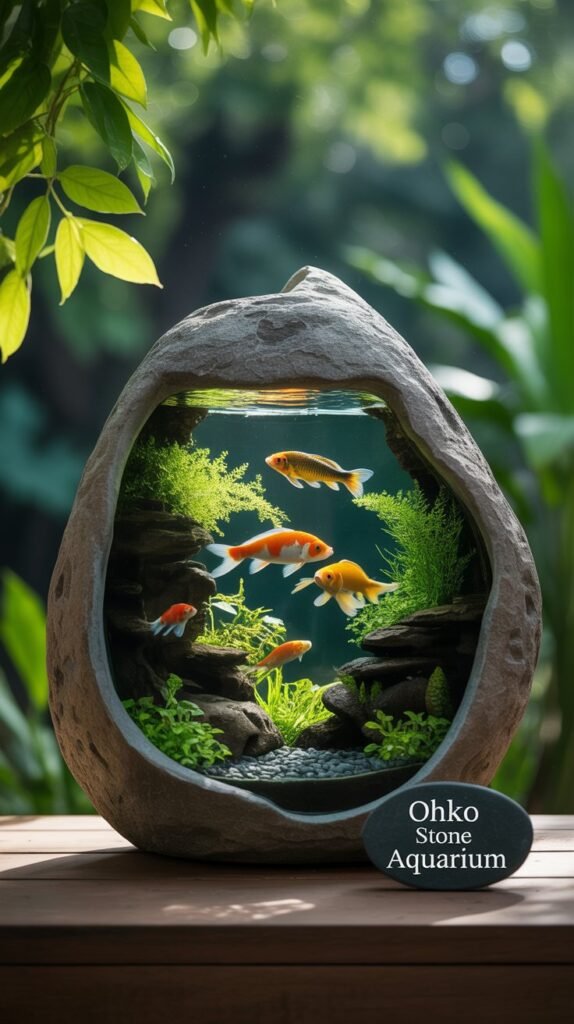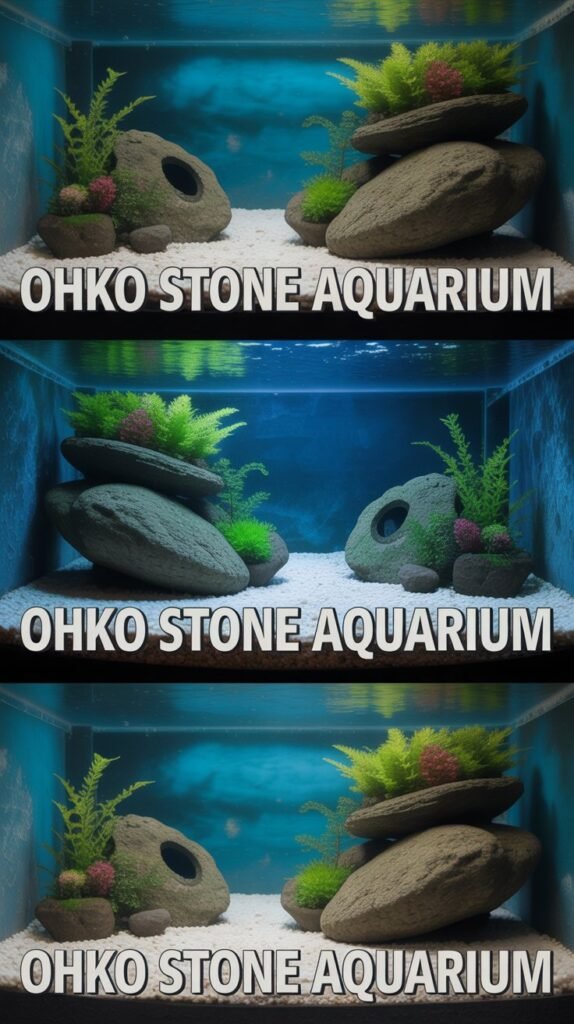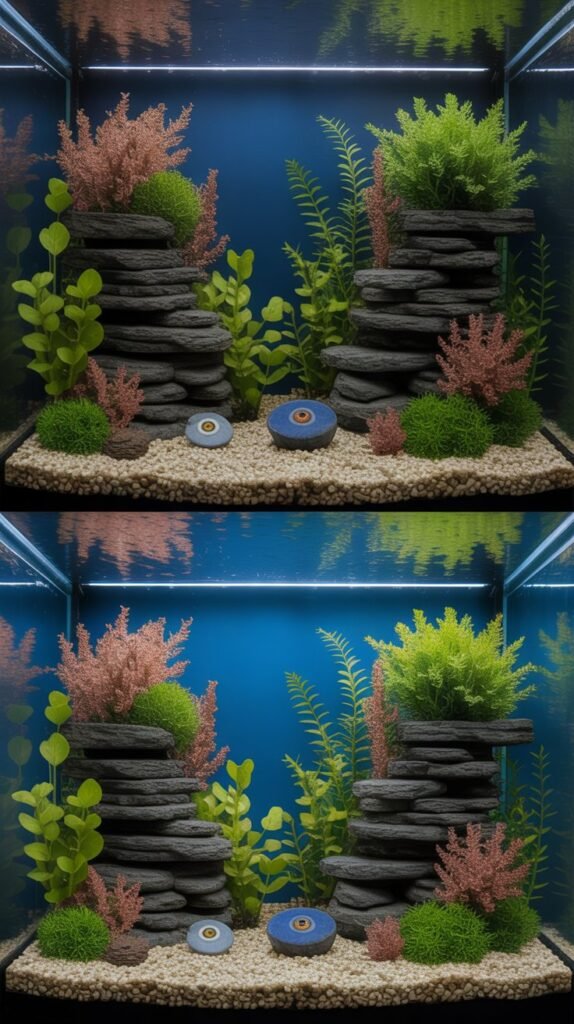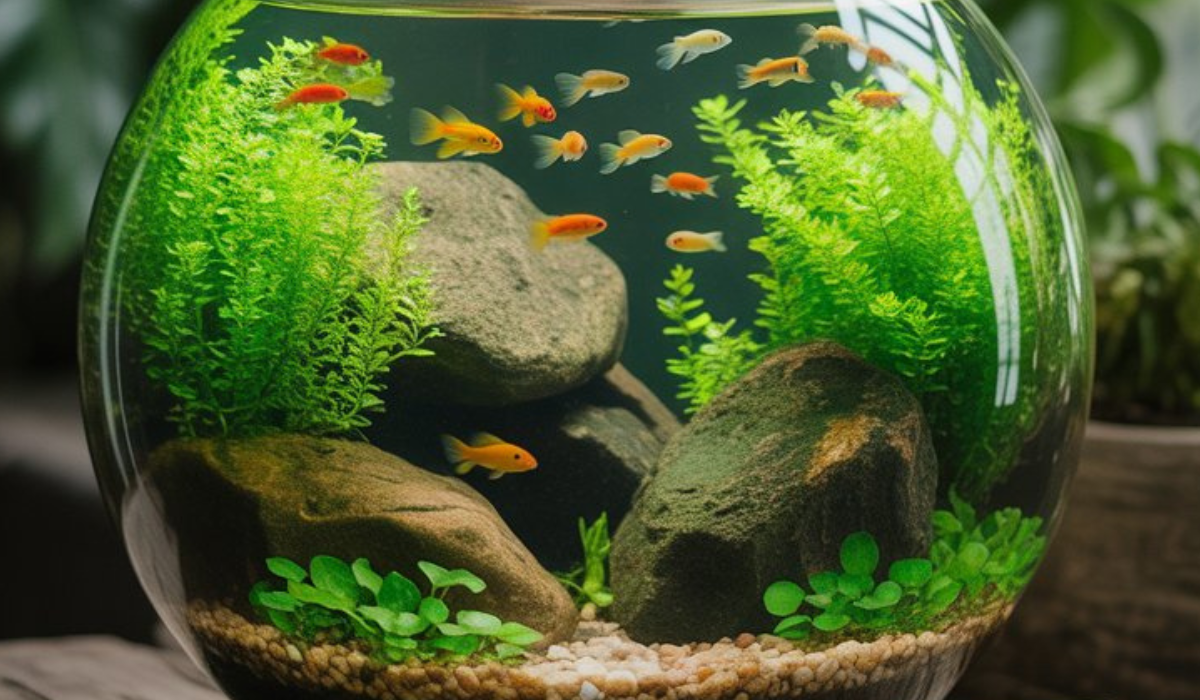Aquascaping is the art of designing underwater landscapes that resemble natural environments, and one of the most visually striking materials in aquascaping is the Ohko Stone, also known as the Dragon Stone. Recognized for its dramatic textures, earthy tones, and natural-looking crevices, Ohko stone has become a favorite among aquascaping enthusiasts around the world.
In this comprehensive guide, we’ll explore everything you need to know about using Ohko Stone in aquariums—from its origin and composition to setup techniques, maintenance, design ideas, and buying tips. Whether you’re new to aquascaping or an experienced hobbyist looking to enhance your tank’s aesthetics, this guide will help you master the art of using Ohko stone for a stunning underwater masterpiece.
What Is Ohko Stone?
Ohko Stone, commonly called Dragon Stone, is a type of clay-based rock popular in aquascaping for its unique, weathered appearance. The name “Ohko” comes from Japanese, where it’s often used in Nature Aquarium layouts inspired by Takashi Amano.

The stone’s texture resembles dragon scales, giving it a rugged and mythical look—hence the nickname Dragon Stone. Its warm, earthy colors range from brown and tan to olive green, and its surface is filled with natural holes and grooves that create depth and realism in aquascapes.
Key Characteristics of Ohko Stone
- Lightweight and porous
- Rich in texture and detail
- pH-neutral (safe for most fish and plants)
- Easy to break and shape
- Naturally beautiful without artificial coloring
These properties make Ohko stone an ideal choice for both freshwater aquariums and planted tanks.
Origin and Composition of Ohko Stone
Ohko Stone is believed to originate from Asia, particularly Japan and Indonesia, where it’s formed by compacted clay and natural weathering processes over thousands of years. The rock’s intricate holes and textures are created by erosion and mineral leaching.
Composition:
- Clay minerals (main component)
- Silica (SiO₂)
- Small amounts of iron oxide (responsible for its reddish tint)
- Trace minerals that provide structural integrity
Because of its clay-based composition, Ohko stone is relatively soft and easy to carve, making it perfect for aquascapers who want to create custom shapes or detailed layouts.
Why Use Ohko Stone in Aquascaping?
Aquascapers love Ohko stone for both aesthetic and practical reasons. Here’s why it’s such a sought-after material:
1. Natural and Realistic Look
The unique surface texture creates a natural, ancient appearance that mimics rocky cliffs, riverbeds, or mountain ranges.
2. Perfect for Aquascape Depth
Ohko stone’s holes and crevices help create the illusion of depth, making even small tanks appear larger and more complex.
3. Safe for Fish and Plants
Unlike limestone or coral, Ohko stone is pH-neutral, meaning it won’t alter your water chemistry—ideal for sensitive freshwater species.
4. Great for Moss and Plant Attachment
The porous surface makes it easy for aquatic mosses (like Java Moss or Christmas Moss) and epiphyte plants (like Anubias and Bucephalandra) to attach and grow naturally.
5. Lightweight and Easy to Arrange
Despite its rugged look, Ohko stone is surprisingly light, making it easy to move and position in tanks of any size.
How Ohko Stone Enhances Aquarium Design
Ohko stone plays a major role in layout composition and artistic expression in aquascaping. It can be used to create various natural themes such as mountain ranges, river valleys, or cliffs.
Popular Aquascaping Styles Using Ohko Stone
1. Iwagumi Style
The Iwagumi style, pioneered by Takashi Amano, uses carefully arranged stones to form a minimalistic yet striking layout.
- The main stone (Oyaishi) is the centerpiece.
- Smaller stones (Fukuishi and Soeishi) complement and balance the composition.
Ohko stone is perfect for this style because of its natural, earthy texture and balance between roughness and elegance.
2. Nature Aquarium Style
In this style, the aquascape resembles real landscapes—like mountains, valleys, or riverbanks. Ohko stone’s weathered appearance perfectly replicates natural terrain.
3. Jungle or Forest Layout
Ohko stones can act as the foundation or “roots” of dense, plant-filled layouts, creating a realistic sense of overgrown forest terrain.
How to Prepare Ohko Stone for Aquarium Use

Before placing Ohko stone in your aquarium, proper preparation is crucial to ensure the safety of your fish and plants.
Step 1: Rinse Thoroughly
Rinse each piece under running water to remove dust, dirt, and clay residue. Use a soft brush to clean deeper crevices.
Step 2: Soak the Stones
Soak the stones in clean water for at least 24–48 hours to remove any remaining debris and prevent cloudiness in the tank.
Step 3: Check for Soft Clay
Some Ohko stones contain loose clay that can crumble. If the water turns murky after soaking, scrub them again or soak longer until clear.
Step 4: Test for pH Stability
Although Ohko is generally pH-neutral, it’s always wise to test it in a separate container for a few days to ensure it doesn’t alter your water chemistry.
How to Use Ohko Stone in Your Aquarium
1. Plan Your Layout
Sketch your aquascape or use a dry run by placing the stones in an empty tank.
The goal is to achieve visual harmony using the Rule of Thirds or Golden Ratio for natural composition.
2. Choose Focal Points
Select a main stone (the largest and most striking) as your centerpiece. Place it off-center to create balance and depth.
3. Layer the Substrate
Use a sloped substrate—higher at the back—to create perspective and enhance the illusion of depth.
4. Arrange the Stones
Start with the largest pieces and gradually add smaller ones. Align their angles and textures to create a natural flow, mimicking geological formations.
5. Add Plants
Attach moss, Anubias, or Bucephalandra to crevices using thread or glue. These plants will grow naturally, softening the rock’s sharp edges.
6. Fill with Water Slowly
To prevent disturbing your layout, pour water gently onto a plate or plastic bag placed over the substrate.
Design Tips for Ohko Stone Aquascapes
- Use Odd Numbers: Always arrange stones in groups of 3, 5, or 7 for a natural look.
- Vary Sizes: Mix large and small stones to avoid symmetry.
- Maintain Flow Direction: Align stone angles to mimic the direction of water or wind movement.
- Balance Negative Space: Leave open sand or gravel areas to create contrast and realism.
- Combine with Driftwood: Mixing Ohko stone with wood creates organic harmony, ideal for nature-style aquascapes.
Compatible Plants for Ohko Stone Aquariums
Ohko stones work beautifully with both carpeting and epiphytic plants. Here are some popular choices:
Carpeting Plants:
- Hemianthus callitrichoides (Cuba)
- Glossostigma elatinoides
- Eleocharis parvula (Dwarf Hairgrass)
- Monte Carlo
Epiphyte Plants (Attach to Stone):
- Anubias nana
- Bucephalandra varieties
- Java Fern (Microsorum pteropus)
- Bolbitis heudelotii
Background Plants:
- Rotala rotundifolia
- Ludwigia palustris
- Vallisneria spiralis
These plants complement Ohko stone’s earthy tones and textures, creating a balanced underwater environment.
Fish and Invertebrates Compatible with Ohko Stone Aquascapes

Ohko stone aquascapes provide excellent hiding spots and territorial boundaries, making them ideal for many species.
Best Choices Include:
- Tetras (Neon, Ember, Cardinal)
- Guppies and Endlers
- Rasboras
- Corydoras Catfish
- Dwarf Gouramis
- Shrimp (Cherry, Amano, Ghost)
- Otocinclus Catfish
- Betta Fish (for minimalist setups)
Avoid large or aggressive species that may dislodge stones or disturb plants.
Does Ohko Stone Affect Aquarium pH?
Generally, Ohko stone is considered inert—meaning it won’t significantly raise or lower pH. However, in rare cases, slight residue from the clay can temporarily cloud water or mildly alter pH for the first few days. Regular soaking and rinsing prevent this issue.
For most freshwater aquariums, Ohko stone is completely safe and won’t interfere with your tank’s chemistry or biological filtration.
Maintenance and Cleaning of Ohko Stone
Maintaining Ohko stone is simple once it’s properly set up.
Routine Maintenance:
- Remove algae using a soft brush or toothbrush weekly.
- Vacuum debris between stones during water changes.
- Avoid harsh scrubbing, which can damage texture.
- Use algae eaters like Amano shrimp or Otocinclus catfish to keep surfaces clean naturally.
Long-Term Care:
Over time, plants and moss will grow over the stones, giving them a more natural, aged appearance—this is part of the beauty of Ohko aquascapes.
Where to Buy Ohko Stone for Aquariums
You can find Ohko stone in:
- Aquascaping stores
- Online aquarium retailers
- Local fish stores
- Aquascaping conventions or expos
When buying:
- Choose stones with varied textures for a natural look.
- Inspect for cracks or loose clay.
- Purchase 3–5 pieces minimum for composition flexibility.
Popular sellers often list Ohko stone by weight (e.g., 5kg, 10kg sets). A general rule is 1.5–2 pounds of stone per gallon for dense layouts.
Pros and Cons of Using Ohko Stone
| Pros | Cons |
|---|---|
| Beautiful, natural texture | Can be expensive |
| Safe for fish and plants | Needs soaking before use |
| Easy to shape and break | Can make water cloudy initially |
| Ideal for all aquascaping styles | Slightly soft and brittle |
| Does not alter pH significantly | Rare in some local markets |
Alternatives to Ohko Stone
If you can’t find Ohko stone, consider these alternatives:
1. Seiryu Stone
Gray-blue rock with sharp edges and white veins. It slightly raises pH and KH—great for cichlid tanks.
2. Lava Rock
Porous and lightweight, perfect for attaching plants. Ideal for filtration support.
3. Manten Stone
Rare and premium-quality stone from Japan; darker and denser than Ohko but equally stunning.
4. Ryuoh Stone
Similar to Seiryu but with more defined patterns—great for dramatic, high-contrast layouts.
Tips for Buying and Arranging Ohko Stone
- Buy More Than You Need: Having extra pieces gives you design flexibility.
- Sort by Size: Group stones into large, medium, and small to create depth.
- Avoid Flat Layouts: Use vertical height differences for visual appeal.
- Combine Textures: Mix stones with fine gravel or sand for realism.
- Test Layout Dry: Always plan your setup before filling with water.
The Role of Lighting in Ohko Stone Aquascapes
Lighting enhances the stone’s natural color and highlights textures.
- Warm white lighting (6,000–7,000K) emphasizes the brown tones.
- High-intensity LED lights bring out depth and shadow contrast.
- For planted tanks, ensure the light supports photosynthesis while keeping algae under control.
Creating a Balanced Ecosystem with Ohko Stone
Using Ohko stone isn’t just about aesthetics—it also contributes to a balanced and healthy ecosystem. The stone’s porous structure provides surface area for beneficial bacteria to colonize, supporting biological filtration.
When combined with healthy plants and consistent maintenance, an Ohko stone aquarium becomes a self-sustaining microhabitat that mimics natural environments beautifully.
Conclusion
The Ohko Stone Aquarium represents the perfect balance of art, nature, and science. Its dragon-like texture, earthy tones, and natural versatility make it one of the most beloved materials in aquascaping. Whether you’re crafting an elegant Iwagumi layout or a lush jungle scape, Ohko stone adds timeless beauty and realism to your aquarium.
By preparing it properly, arranging it thoughtfully, and maintaining it regularly, you can create an aquascape that captivates anyone who sees it—a serene underwater world inspired by nature’s artistry.
FAQs About Ohko Stone Aquarium
1. What is Ohko stone made of?
Ohko stone is a clay-based rock composed mainly of silica and minerals, formed naturally through weathering and erosion.
2. Why is it called Dragon Stone?
Its surface resembles dragon scales, giving it the nickname “Dragon Stone” in the aquascaping community.
3. Does Ohko stone change aquarium pH?
Generally, no. It’s pH-neutral and safe for all freshwater tanks, though slight temporary changes may occur initially.
4. How do I clean Ohko stone before use?
Rinse thoroughly, scrub off dirt, and soak for 24–48 hours to remove loose clay and prevent cloudiness.
5. Can I use Ohko stone in planted aquariums?
Absolutely! It’s ideal for planted tanks and provides an excellent surface for moss and epiphyte attachment.
6. Is Ohko stone safe for shrimp and snails?
Yes, it’s completely safe for invertebrates and does not leach harmful substances.
7. How much Ohko stone should I buy for my aquarium?
A general rule is 1.5–2 pounds of stone per gallon of water, depending on layout density.
8. Can I combine Ohko stone with other hardscapes?
Yes, combining it with driftwood or different rock types adds contrast and enhances the natural look.
9. Does Ohko stone cloud the water?
If not rinsed or soaked properly, it may cause temporary cloudiness. Soaking before use prevents this issue.
10. How long does Ohko stone last in an aquarium?
Indefinitely. It’s a durable, natural rock that doesn’t degrade over time when properly maintained.

